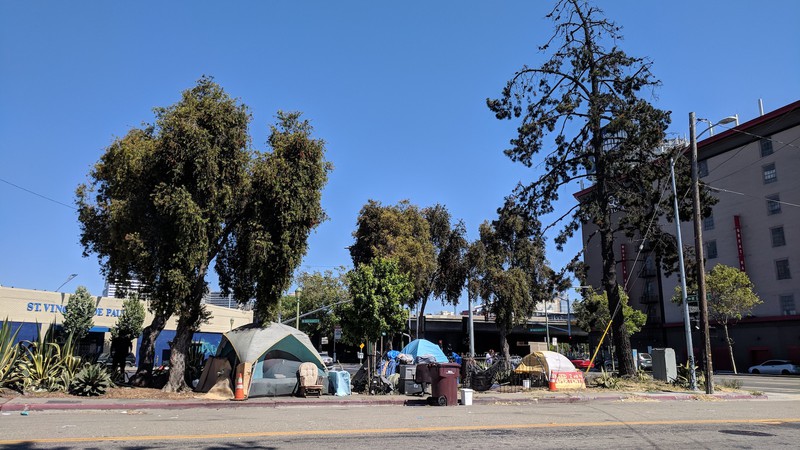Gov. Newsom signs legislation to bring housing where closed big-box stores once stood.

The state's housing crisis drags on, but 2 new laws aim to ease the dire situation. Grendelkhan / Wikimedia Commons C.C. 4.0 Share-Alike License
A week after he gave the green light to a groundbreaking piece of legislation that eased up parking requirements on certain housing developments, Gov. Gavin Newsom signed two more bills aimed at finally turning the tide in California’s seemingly endless housing crisis. The new laws, part of a binder of legislation 41 bills thick now signed by the governor, aim to create thousands of new housing units while also providing decent-paying jobs for workers building the new dwellings.
Some labor unions initially opposed the laws, resulting in a compromise that ultimately allowed both bills to win legislative approval even though they appear to contradict each other on some points, albeit leading to the same goal—allowing some areas zoned for businesses to be used as sites for new housing projects.
Particularly in rural California—but in urban and suburban areas as well—the state has lost dozens of large chain stores over the past few years. Housewares outlet Bed Bath and Beyond in September announced plans to close 50 stores by the end of 2022, eight of them in California. Technology retailer Fry’s Electronics—based in San Jose and a Silicon Valley icon in its own right—shut down all 17 of its warehouse-style California locations (plus 14 stores in other states) in 2021.
Sears, in its heyday the nation’s largest retailer, shut down five California stores in 2021 including one that had served customers in Pasadena for 63 years. Even the nonprofit Goodwill axed eight of its retail stores in the Bay Area alone in 2021. Each of those closed stores, representing just a sample of the retail shutdowns in recent years, could now be converted to housing, under the new laws signed by Newsom.
AB 2011, the Favorite of Housing Advocates
The first of the bills signed by Newsom Sept. 28, AB 2011, was considered “the most substantive affordable housing proposal on the table this year,” according to a Los Angeles Times report. The bill allows a streamlined approval process for housing developments built in the commercial spaces, provided that the projects are made up of at least 15 percent “affordable” units.
The law could lead to construction of between 1.6 million and 2.4 million new homes, according to a study spearheaded by the consulting firm Urban Footprint. Of those 300,000 to 400,000 would be classified as “affordable” for middle and low-income families. “Affordable” housing is restricted only to people and families defined as “low-income,” which means that the household earns no more than 80 percent of the Area Median Income. For example, the 2022 Area Median Income in Los Angeles County for a family of four is $91,100. That’s a big jump from $80,000 in 2021.
According to a widely-cited 2016 analysis by the corporate consultant McKinsey and Company, California has a shortage of about 2 million housing units. To cover that gap and meet “pent-up demand,” the study said at the time that California must build 3.5 million new homes by 2025. The study also found that half of California households could not afford housing in their local markets.
Of the two bills signed by Newsom, AB 2011 was the favorite of affordable housing advocates due to its no-nonsense approach to creating new housing units. The bill snatches the authority to approve new housing away from local governments and instead creates a “ministerial” process—meaning that projects must simply meet a checklist of objective requirements to receive approval, freeing them from the judgments of local officials. They are exempt as well from review under the California Environmental Quality Act, though the law mandates strict standards for limiting greenhouse gas emissions.
SB 6, Backed by Labor Organizations
The other bill signed by Newsom, SB 6, also allows housing development in commercially-zoned areas without actually changing the zoning—but the bill does not expedite the process by allowing ministerial approval, as AB 2011 does. That means local officials will be able to weigh in on new projects proposed under SB 6, and put them through the typical approval process.
The law also contains no requirements that housing be affordable. Instead, the law focuses on the labor employed to build new housing. To gain approval under SB 6, a project must commit to hiring workers who are “skilled and trained,” a stipulation generally interpreted to mean that developers must use union labor, and pay union wages.
If a project fails to attract two bids from “qualified” contractors—that is, those employing “skilled and trained” workers—it becomes exempt from the quasi-union labor requirement. But developers must still pay workers “prevailing” wages for the project.
As a result, the State Building and Construction Trades Council of California (colloquially known as The Trades) which represents 450,000 construction workers throughout the state supported SB 6 but opposed AB 2011. It wasn’t the first time that The Trades had opposed legislation for affordable housing, or climate change, or other priorities favored by the legislature’s Democratic majority and the state’s Democratic governor. Another union, the California Conference of Carpenters, supported AB 2011, however.
But this time, legislators managed to strike a deal allowing both bills to go forward. The “two-bid” system in SB 6, allowing non-union workers to be used where “skilled and trained” labor is unavailable, was a key concession in the deal, as was removing what had been an affordable housing minimum requirement in SB 6.
The deal, however, still failed to win public support from the head of The Trades, just an agreement not to actively oppose the bill.